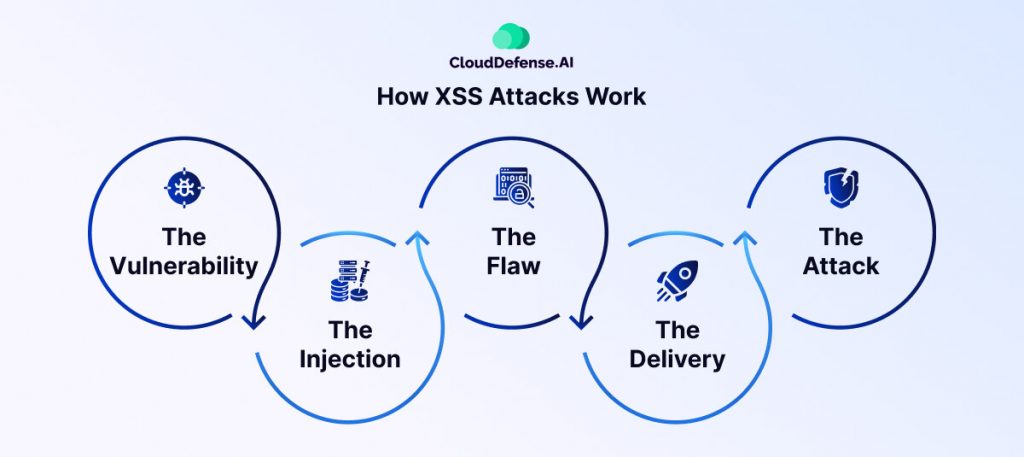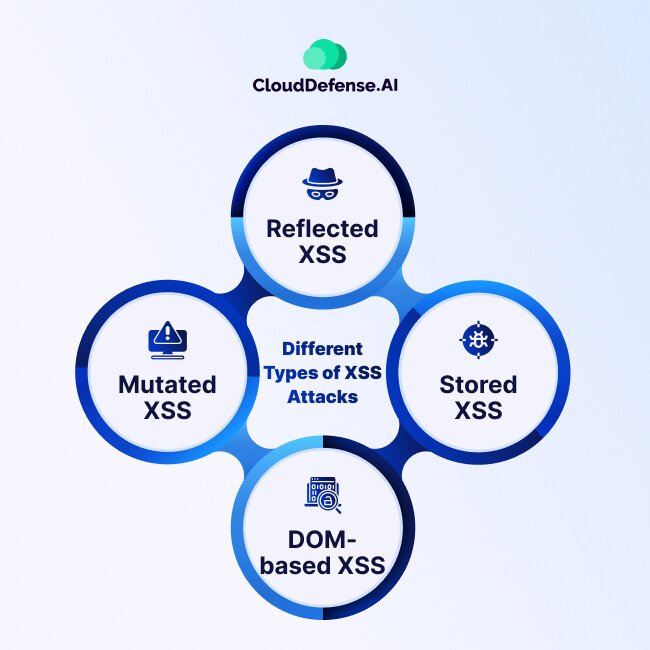Have you ever wondered how hackers can hijack your web browser and steal sensitive information like passwords, and credit card numbers, or even impersonate you on websites? It’s not magic, but rather a sneaky technique called Cross-Site Scripting (XSS) that allows malicious actors to inject malicious code into trusted websites.
XSS exploits trust. Hackers inject scripts into websites you visit, and when your browser executes them, they gain a foothold within your session. This can lead to stolen data, manipulated actions, and even complete account takeovers.
Keep reading as we explore more about what is Cross-Site Scripting, how it works, the different types of XSS attacks, and most importantly, how you can protect yourself from falling victim to these devious hacks.
Cross-site scripting (XSS) – Definition
Cross-site scripting (XSS) is a type of web security vulnerability that allows attackers to inject malicious scripts into trusted websites. These scripts are then executed by the victim’s browser when they visit the compromised website. It’s like a Trojan Horse, hiding within a seemingly safe environment to unleash its attack.
XSS vulnerabilities arise when web applications fail to properly validate or sanitize user input. This means that attackers can sneak malicious code into forms, comments, or other parts of the website. When this untamed input is displayed back to users without proper filtering, the attacker’s script gets executed alongside the legitimate website code.
How XSS Attacks Work

Cross-site scripting (XSS) attacks exploit a weakness in how web applications handle user input. Here’s a breakdown of the deceptive process:
1. The Vulnerability: A web application, like a forum or a comment section, allows users to submit data. This data could be anything from a username to a product review.
2. The Injection: The attacker injects malicious code, often in the form of JavaScript, into this user input. This code could be hidden within seemingly harmless text or disguised as special characters.
3. The Flaw: The web application fails to properly validate or sanitize the user input. This means it doesn’t check for malicious code and simply incorporates the attacker’s script into the website’s code.
4. The Delivery: When another user visits the website, the malicious script is delivered along with the legitimate content. The user’s browser unknowingly executes both the website’s code and the attacker’s hidden script.
5. The Attack: Once executed, the attacker’s script can perform various malicious actions. These could include stealing the user’s cookies (which contain login information), redirecting them to phishing sites, or even altering the content they see on the website.
Imagine a comment section where someone writes a funny message that also includes a hidden script. When you, as another user, view that comment, the script embedded within the message runs on your browser without your knowledge. This is how XSS exploits trust and injects malicious code into seemingly safe websites.
Different Types of XSS Attacks

Cross-Site Scripting (XSS) attacks come in various flavors, each with its own sneaky tactics. Let’s explore the three main types of XSS vulnerabilities:
Reflected XSS
This one is all about getting malicious scripts reflected right back at the victim from the website itself. It’s kind of like that old prank call trick where you pretend to be someone else, except with code instead of voices.
Here’s how it might go down – let’s say there’s a search field on a site that doesn’t properly sanitize user input. A hacker could craft a mischievous script and sneak it into the URL as part of the search query.
So when some unsuspecting user clicks that rigged URL link, their browser pulls up the search results page as usual. But surprise! It also renders the hacker’s script right alongside the legitimate content, giving it the same access and privileges. Reflected, executed, and now the browser is compromised.
Stored XSS
With this type, the malicious script gets permanently stored on the website’s servers, usually in a database. It’s like leaving a virus behind to keep infecting new victims.
A super common way this happens is through anything that allows user-generated content – comment boxes, user profiles, upload functionality, you name it. If the website doesn’t properly sanitize that input before saving it, bam, the script gets stored.
Then every visitor who views that content has the malicious script served right up and executed by their browser. It keeps happening automatically until the website gets its act together and removes the payload. Persistent, hard to track down, real evil stuff.
DOM-based XSS
This one targets vulnerabilities within the client-side scripting of a web page, usually JavaScript. The malicious code doesn’t necessarily get stored anywhere. Instead, the attacker manipulates the way the web page interacts with the user’s browser to inject the script. This can be done through various techniques, such as exploiting weaknesses in how the browser handles URLs or manipulating the Document Object Model (DOM), the structure of a web page.
Mutated XSS
I’ll be honest, this one is pretty obscure, but still worst of all. Basically, a seemingly innocent script on the website gets mutated and manipulated by the attacker to become malicious.
Maybe the site has a script to try to filter out “<script>” tags to prevent XSS, but the attacker finds a way to bypass or obfuscate their payload to sneak around that filter. It’s like a code virus evolving to defeat security measures.
At the end of the day, all these XSS variants are examples of websites dropping the ball on validating and sanitizing untrusted user inputs before using them. The browser thinks it’s legit code, executes it, and boom – you just got hacked without realizing.
How to Find and Test for XSS Vulnerabilities
Now that we’ve covered what XSS is and how it works, the next big question is – how do you actually find and test for these vulnerabilities?
Manual Testing:
- Identify Input Points: The first step is scoping out everywhere on the website that lets you, the user, submit data. We’re talking search bars, comment sections, login forms – anything that takes your input is a potential XSS vector.
- Craft Test Cases: For each input point, design test cases that inject various payloads containing common XSS attack vectors like <script>, <img>, and event handlers (e.g., onclick).
- Observe Browser Behavior: Once you’ve submitted your test cases, monitor your browser’s behavior. Look for signs of the script being executed, such as alert messages, unexpected page reloads, or altered content.
Automated Tools:
- Web Vulnerability Scanners: Tools like Burp Suite and OWASP ZAP can automate the process of identifying potential XSS vulnerabilities by sending various payloads to the web application and analyzing the response.
- Static Code Analysis: These tools can scan the website’s codebase for patterns that might indicate XSS vulnerabilities, helping developers identify potential issues early in the development process.
Ethical Considerations:
- Always obtain permission: Before testing any website for vulnerabilities, it’s crucial to get written permission from the website owner. Testing without permission is illegal.
- Focus on education: The goal of testing is to identify vulnerabilities and help the website owner fix them, not exploit them for personal gain.
So there you have it – the full recon guide for sniffing out those pesky XSS vulnerabilities before the bad guys can leverage them. Stay vigilant and keep websites on their toes, my ethical hacker friends.
How to Avoid XSS Vulnerabilities
Cross-site scripting (XSS) attacks can be a real pain, but there are steps you can take to protect yourself as a web user:
1. Be Wary of User-Generated Content: Exercise caution when interacting with websites that heavily rely on user-generated content, such as forums, comment sections, and social media platforms. Malicious actors often exploit these areas to plant XSS scripts.
2. Think Before You Click: Don’t click on suspicious links or download attachments from unknown senders, even if they appear to come from a trusted source. Phishing emails are a common way for attackers to deliver XSS payloads.
3. Keep Your Software Updated: Outdated web browsers and plugins are more susceptible to XSS exploits. Regularly update your software to benefit from the latest security patches.
4. Enable Security Features: Many browsers offer built-in XSS protection features. Explore your browser’s security settings and enable options that block malicious scripts or warn you about potentially risky websites.
5. Be Mindful of What You Share: Limit the amount of personal information you share online, especially on untrusted websites. Attackers can use stolen data like usernames and passwords to launch further cyberattack.
6. Use a Web Application Firewall (WAF) (Advanced Users): For advanced users, consider using a WAF as an additional layer of protection. WAFs can filter incoming traffic and block malicious requests that might contain XSS payloads.
At the end of the day, staying safe from XSS is all about being proactive about what you click, download, and interact with online. As long as you keep your guard up and don’t blindly trust everything your browser shows you, those pesky XSS exploits shouldn’t be able to get a foot in the door.

Anshu Bansal, a Silicon Valley entrepreneur and venture capitalist, currently co-founds CloudDefense.AI, a cybersecurity solution with a mission to secure your business by rapidly identifying and removing critical risks in Applications and Infrastructure as Code. With a background in Amazon, Microsoft, and VMWare, they contributed to various software and security roles.








